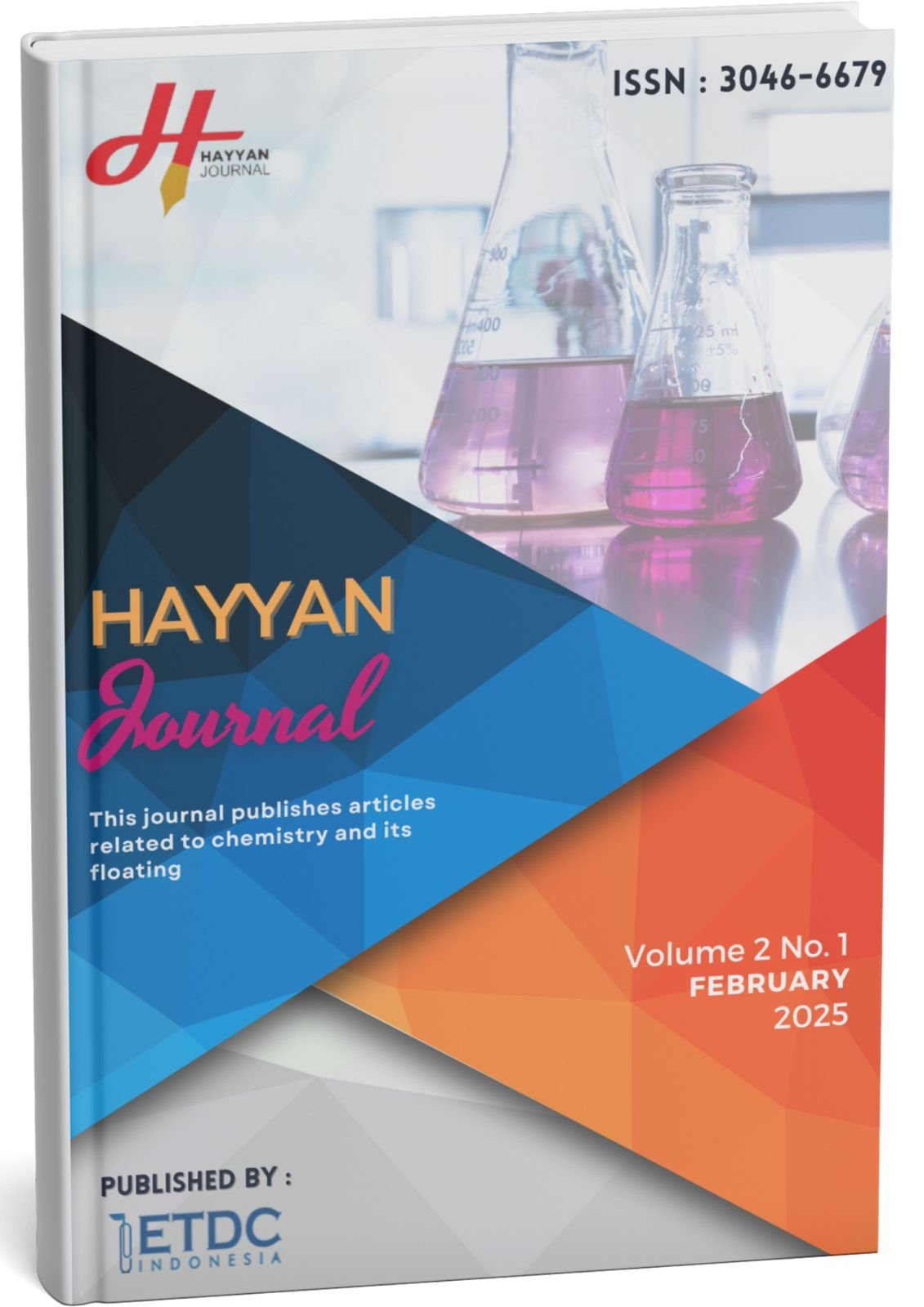Review Article: Phytochemical Screening and Potential Biological Activities of Lahuna Plants ( Chromolaena odorata L.)
DOI:
https://doi.org/10.51574/hayyan.v2i1.3129Keywords:
Chromolaena odorata, Phytochemistry, Secondary Metabolites, Biological ActivityAbstract
Chromolaena odorata L., locally known as the Lahuna plant, is a tropical plant with great potential in traditional medicine. This study uses a qualitative approach method that critically examines the results of previous studies on the phytochemical content and potential biological activity of the Chromolaena odorata L. plant. This review article discusses the results of phytochemical screening and the potential biological activity of various secondary metabolite compounds contained in the plant, such as flavonoids, alkaloids, saponins, tannins, and terpenoids. Various studies have shown that C. odorata has broad pharmacological activities, including antibacterial, anti-inflammatory, antioxidant, and wound-healing agents. With its abundant bioactive content, this plant has great potential to be developed as a source of natural medicine. However, its clinical use still requires further scientific validation through toxicity tests, pharmacodynamics, and clinical trials. This article aims to provide a scientific basis for the potential of C. odorata in the field of phytopharmaceuticals and encourage further research for its development.
References
[1] Sudewi S, Saleh AR. Diversity of Species and Potential of Wild Plants in the Former Liquefaction Area of Jono Oge Village, Sigi Regency, Central Sulawesi. Biofarm J Ilm Pertan 2023;19:46. https://doi.org/10.31941/biofarm.v19i1.2792.
[2] Jumrah E, Agustina AS. Formulation of Lahuna Leave Extract (Chromolaena odorata) and Binahong Leave Extract (Anredera cordifolia) As Antiseptic Ointments. J Acta Kim Indonesia (Indonesia Chim Acta) 2023:54–61. https://doi.org/10.20956/ica.v16i2.29931.
[3] Jumrah E, Abubakar ANF, Agustina AS, Karneng S, Gusti HI. Formulation of Lahuna Leave (Eupatorium odoratum) and Sirih Leave Extract (Piper betle L.) as Antiseptic Liquid Soap. Indo J Chem Res 2023;10:157–63. https://doi.org/10.30598//ijcr.2023.10-jum.
[4] Onwuzuligbo CC, Okafor IS, Onwuzuligbo AU. Formulation and evaluation of antimicrobial properties of ointment of Chromolaena odorata ethanolic extract. Formulation and evaluation of antimicrobial properties of ointment of Chromolaena odorata ethanolic extract. World J Biol Pharm Heal Sci 2025;22:028–36. https://doi.org/10.30574/wjbphs.2025.22.1.0361.
[5] Jonathan, Hairani R RR. PHYTOCHEMICAL SCREENING AND TOXICITY ASSAY OF DICHLOROMETHANE EXTRACT OF FINGER ROOT ( Boesenbergia rotunda ) RHIZOME. Jonathan 1, Rita Hairani 1,2, Ritbey Ruga 2024;9:62–8.
[6] Febriani Y, Ansyah A, Razali M, Margata L. ANTIBACTERIAL ACTIVITY TEST OF ETHANOL EXTRACT OF KIRINYUH LEAVES (Chromolaena odorata) AGAINST THE GROWTH OF Escherichia coli AND Staphylococcus aureus BACTERIA. Forte J 2024;4:225–31. https://doi.org/10.51771/fj.v4i1.791.
[7] Marsella VR, Marsella VR, Aswat MR, Sciences N, Sciences N. ANTIOXIDANT ACTIVITY AND TOXICITY OF ETHANOL EXTRACT OF BALAKACIDA LEAVES (Cromolaena odorata L.). Pros. Semin. Nas. Kim. and Terap., 2024, p. 10–7.
[8] Utami YP, Mubarak F, Rahman NF. Variation of Tekelan Leaf Drying Technique (Chromolaena odorata L.) Affects Antioxidant Activity: Laboratory Research with ABTS Method. Heal Inf J Penelit 2023;15:180–9. https://doi.org/10.36990/hijp.v15i2.775.
[9] Erwin E, Usman U. Bioactivity and Chemical Compound Content of Merung Plant (Coptosapelta tomentosa). J Science And Health 2023;5:402–8. https://doi.org/10.25026/jsk.v5i3.1417.
[10] Fazri PB, Munira NM. Antibiofilm activity test of kirinyuh leaf extract (Chromolaena odorata l.) from the Ie Seum geothermal area against staphylococcus aureus. SAGO Nutrition and Health 2024;5:788–94.
[11] Purwaeni P, Ningsih HY, Wahyu C. Test of the Effect of Kirinyuh Leaf Extract (Chromolaena odorata) on Blood Clotting Time In Vitro Using the Lee-White Method. J Health Rajawali 2023;13:34–7. https://doi.org/10.54350/jkr.v13i1.165.
[12] Asigbaase M, Adusu D, Musah AA, Anaba L, Nsor CA, Abugre S, et al. Ethnobotanical and ethnopharmacological survey of medicinal tree species used in the treatment of diseases by forest-fringe communities of Southwestern Ghana. Heliyon 2024;10:e23645. https://doi.org/10.1016/j.heliyon.2023.e23645.
[13] Cahyo ASD, Oktavia S, Ifora I. Anti-Inflammatory and Analgesic Potential of Chromolaena odorata: A Review. Int J Pharm Sci Med 2021;6:8–16. https://doi.org/10.47760/ijpsm.2021.v06i09.002.
[14] Ernawati E, Jannah N. Antimicrobial Activity of Kirinyuh Leaf Juice (Chromolaena odorata L.) against Candida albicans and Pseudomonas aeruginosa. J Medicine And Health 2021;17:137. https://doi.org/10.24853/jkk.17.2.137-144.
[15] Nurlely N, Rahmah A, Ratnapuri PH, Srikartika VM, Anwar K. Physical Characteristics Test of Kirinyuh Leaf Extract Gel Preparations (Chromolaena odorata L.) with Variations of Carbopol and HPMC. J Pharmascience 2021;8:79. https://doi.org/10.20527/jps.v8i2.9346.
[16] Jamilah S, Prihandini YA, Wahyunita S. Activity Test of Methanol Extract of Kirinyuh Leaves (Chromolaena Ododrata L.) Against Staphylococcus Epidermidis Bacteria. Malahayati Nurs J 2024;6:677–88. https://doi.org/10.33024/mnj.v6i2.11623.
[17] Fadia F, Nurlailah N, Helmiah TE, Lutpiatina L. Effectiveness of Ethanol Extract of Kirinyuh Leaves (Chromolaena Odorata L) as Antibacterial for Salmonella Typhi and Staphylococcus Aureus. J Ris Kefarmasian Indones 2020;2:158–68. https://doi.org/10.33759/jrki.v2i3.104.
[18] Listiani PAR and, Indraswari PII. Formulation, Physical Quality Evaluation, and Antifungal Activity Test (Chromolaena odorata (L.) R. M. King & H. Rob.) Formulation, Physical Evaluation, and Antifungal Activity Determination of Transparent Soap Containing 96% Ethanol Extract of Siam Weed. Pharm J Farm Indonesia 2021;18:324–33.
[19] Diba F, Nauli UR, Winarsih W, Oramahi HA. The Potency of Kirinyuh (Chromolaena odorata L.) and Basil leaf (Ocimum basilicum) as Biopesticide against Schizophyllum commune Fries. J Biol Trop 2022;22:304–14. https://doi.org/10.29303/jbt.v22i1.3023.
[20] Juan A. Phytochemical and Oral Toxicity Studies of Chromolaena odorata L. (King and Robinson)Leaf Extract. Cent Mindanao Univ J Sci 2021;25.
[21] Nike Haryani, Damhuji, Budi Suryana 2022. Metabolite Profiling of Kirinyuh Leaf (Chromolaena Odorata L.) Ethanol Extract using UPLC-MS. J Dental Health 2024;11:173–81.
[22] Aulia A, Umam K. Antibacterial Screenings of Chromolaena odorata L. and its potential against Staphyloccocus aureus, Bacillus subtilis, Staphyloccocus typhimurium, and Escherhicia coli in Sumbawa. J Biol Trop 2022;22:1077–83. https://doi.org/10.29303/jbt.v22i3.4220.
[23] Rafsanjani, A. WAYT. Effectiveness of Pki (Chromolaena Odorata L.) Leaf Cream Preparation for Healing Cut Wounds in Rabbits ( Oryctolagus Cuniculus). J Surya Med 2025:358–63. https://doi.org/https://doi.org/10.33084/jsm.v11i2.6095.
Published
Versions
- 2025-02-23 (2)
- 2025-05-19 (1)


